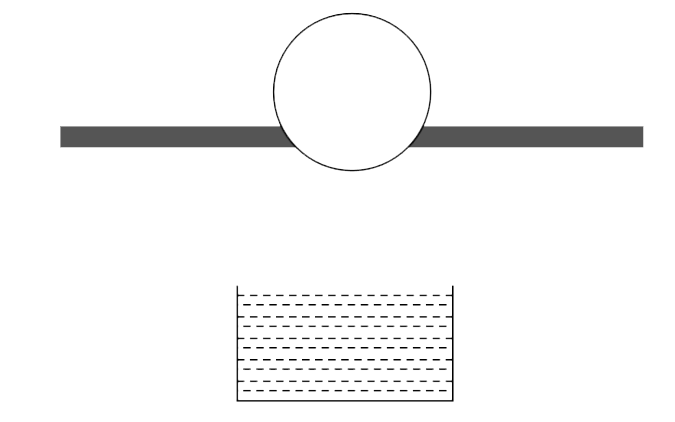In an aluminium sheet there is a hole of diameter 1 m and is horizontally mounted on a stand. Onto this hole an iron sphere of diameter 1.004 m is resting. Initial temperature of this system is 25∘C. Find at what temperature, the iron sphere will fall down through the hole in sheet. The coefficients of linear expansion for aluminium and iron are 2.4×10−5and1.2×10−5 respectively.Solution in Telugu
As value of coefficient of linear expansion for aluminium is more than that for iron, it expands faster than iron. So at some higher temperature when diameter of hole will exactly become equal to that of iron sphere, the sphere will pass through the hole. Let it happen at some higher temperature T. Thus we have at this temperature T,
(diameter of hole)Al=(diameter of sphere)iron
1[1+αAl(T−25)]=1.004[1+αiron(T−25)]
αAl(T−25)=0.004+1.004αiron(T−25)
or T=(0.004αAl−1.004αiron+25)∘C
or T=0.0041×2.4×10−5−1.004×1.2×10−5+25
or T=359.7∘C
Topper's Solved these Questions
- THERMAL PROPERTIES OF MATTERBOOK - AAKASH SERIESCHAPTER - THERMAL PROPERTIES OF MATTEREXERCISE - EXERCISE-IA
217 Videos
- THERMAL PROPERTIES OF MATTERBOOK - AAKASH SERIESCHAPTER - THERMAL PROPERTIES OF MATTEREXERCISE - EXERCISE-IB
68 Videos
- SYSTEM OF PARTICLES AND ROTATIONAL MOTIONBOOK - AAKASH SERIESCHAPTER - SYSTEM OF PARTICLES AND ROTATIONAL MOTIONEXERCISE - PRACTICE EXERCISE
99 Videos
- THERMODYNAMICSBOOK - AAKASH SERIESCHAPTER - THERMODYNAMICSEXERCISE - EXERCISE - 3
33 Videos
Similar Questions
The equivalance of two systems in thermal equilibrium is represented by the property of
View Solution(A) : Metals are isotropic solids
( R) : Metals are composed of large number of minute crystals which are randomly oriented resulting in isotropy
View SolutionThe centre of mass of two particles with masses 2kg and 6 kg located at (1,1,1), (2,2,1) respectively has the coordinates
View SolutionA bullet of mass 10×10−3 moving with a speed of 20ms−1 hits an ice block (0∘C) of 990g kept at rest on a frictionless floor and gets embedded in it. If ice takes 50% of K.E, the amount of ice melted (in grams) approximately is (J=4.2J/cal) (latent heat of ice=80cal/g)
View SolutionAn alumimum plate fixed in a horizontal position has a hole of diameter 2.000 cm. A steel sphere of diameter 2.005 cm rests on this hole. All the lengths refer to a temperature of 10^C .The temperature of the entire system is slowly increased. At what temperature will the ball fall down? coefficient of linear expansion of aluminium is 23 xx 10^(-6) o^C(-1) and that of steel is 11 xx 10^(-6) 0^C^(-1) .
View SolutionAn iron sphere of radius 10cm is at temperature , 10∘C. If the sphere is heated upto temperature 110∘C , find the change in the volume of the sphere coefficient of linear expansion of iron = 11×10−6.∘C−1
View SolutionA table top is made of aluminium and has a hole of diameter 2 cm. An iron sphere of diameter 2.004 m is resting on this hole. Below the hole, an insulated container has 2 kg of water in it. Everything is at ambient temperature of 25∘C. The table top along with the iron sphere is heated till the ball falls through the hole into the water. Find the equilibrium temperature of the ball and water system

Neglect any heat loss from ball–water system to the surrounding and assume the heat capacity of the container to be negligible.
Relevant data: Coefficient of linear expansion for aluminium and iron are 2.4×10−5.∘C−1 and 1.2×10−5.∘C−1 respectively. Specific heat capacity of water and iron are 4200J.∘C−1g−1 and 450J.∘C−1g−1 respectively. Density of iron at 25∘C is 8000kg/m3.
View SolutionA circular hole in an aluminium plate has a diameter of 4cm at 0^(@)C . What is its diameter when the temperature of the plate is raised to 100^(@)C ? (Linear expansivity of aluminium =23xx10^(-6)K^(-1) )
View Solutionताँबे की चादर में एक छिद्र किया गया है | 27.0∘C पर छिद्र का व्यास 4.24cm है | इस धातु की चादर को 227∘C तक तप्त करने पर छिद्र के व्यास में क्या परिवर्तन होगा ? ताँबे का रेखीय प्रसार गुणांक =1.70×10−5K−1 |
View SolutionIn an aluminium there is a hole of diameter 2 m and is horozontally mounted on a stand. Onto this hole an iron sphere of diameter 2.004 m is resting. Initial temperature of this system is 25∘C. Find at what temperature the iron sphere will fall down through the hole in sheet. The coefficient of linear expansion for aluminium and iron are 2.4×10−5 and 1.2×10−5 respectively.
View SolutionA hole is drilled in a copper sheet. The diameter of the hole is 4.24cm at 27.0^(@)C . What is the change in the diameter of the when the sheet is heated to 227^(@)C ? Coefficient of linear expansion of copper =1.70xx10^-5""^(@) C^(-1) ?
View SolutionThe coefficient of linear expansion of aluminium is 23×10−6/∘C . A circular hole in an aluminium plate 2.725 is cm in diameter at 0∘C .What is the diameter of the hole if the temperature of the plate is raised to 100∘C ?
View SolutionA hole is drilled in a copper sheet. The diameter of the hole is 4.24 cm at 27.0^(@)C . What is the change in the diameter of the hole when the sheet is heated to 227^(@)C ? Coefficient of linear expansion of copper =1.70xx10^(-5)K^(-1) .
View SolutionIn an aluminium sheet there is a hole diameter 1 m and is horizontally mounted on a stand. On this hole an iron sphere of diameter 1.004 m is resting. Initial temperature of this system is 25∘C. Find at what temperature, the iron sphere will fall down through the hole in sheet. The coefficients of linear expansion for aluminium and iron are 2.4×10−5and1.2×10−5 respectively.
View SolutionA hole is drilled in a copper sheet. The diameter of the hole is 4.24cm at 27.0∘C. What is the change in the diameter of the hole when the sheet is heated to 2270C? α for copper =1.70×10−5K−1
View Solution
